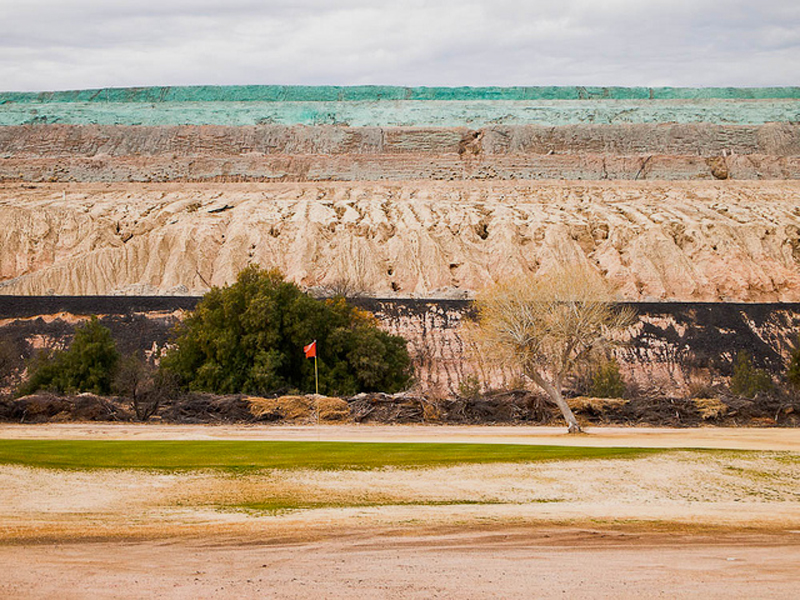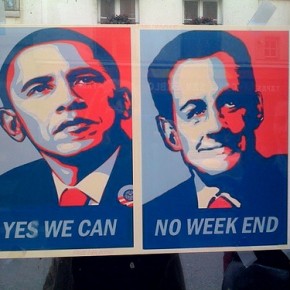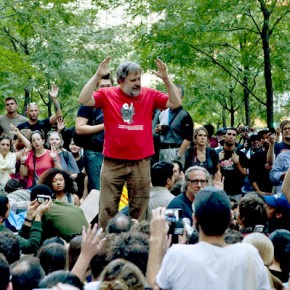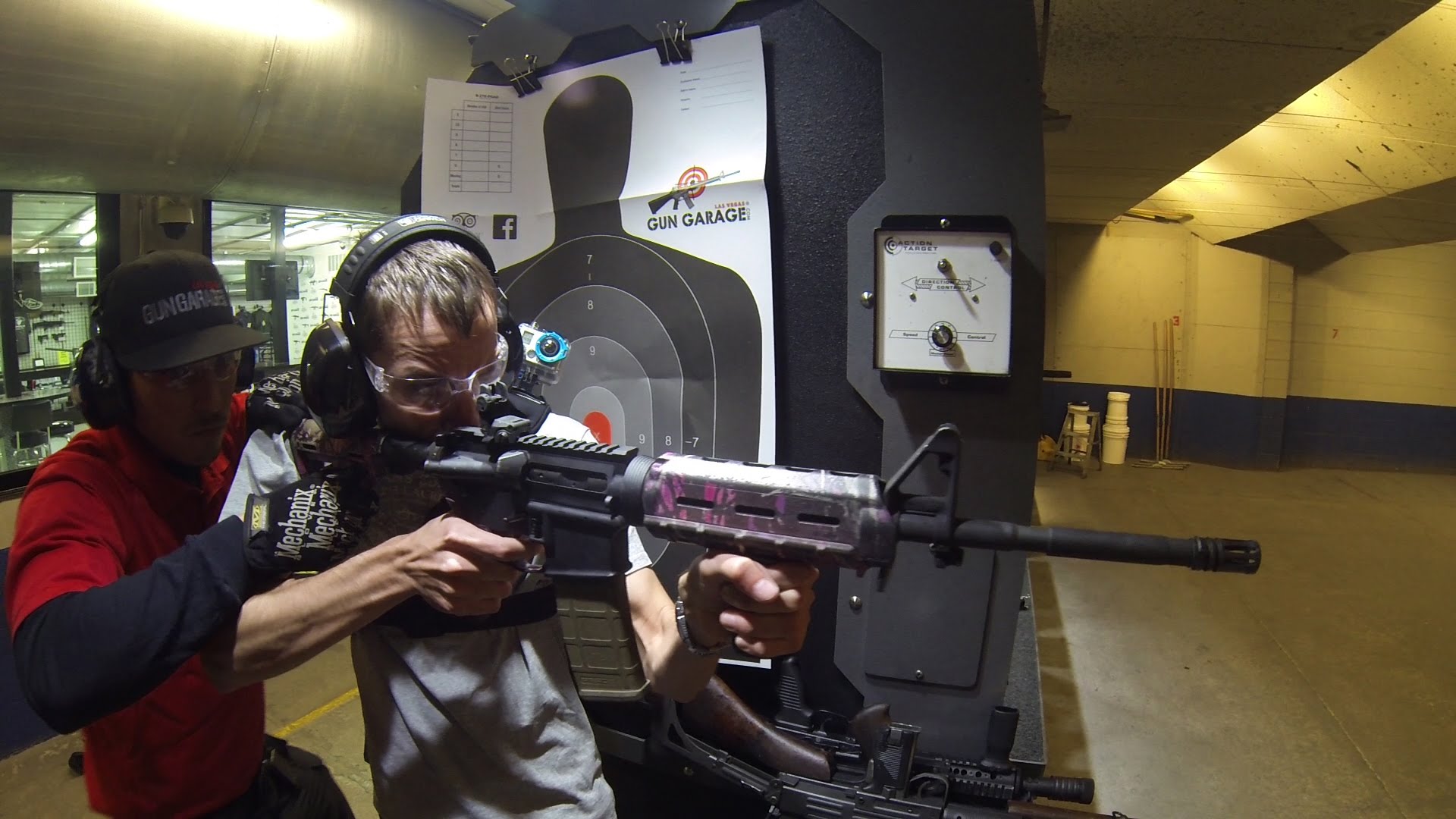We were stunned by the bleak beauty of the golf course when we first found it. It was like something out of a dream, the kind of place you find yourself wandering through in the middle of your sleep, a place with no beginning and no end, a place out of place and out of time.
My friend Mark and I discovered it last February when we were first beginning to conceive of our weekend trips through some of Arizona’s bleakest hinterlands as a Copper Belt Project. We were driving the back roads of Winkelman, one of the region’s tenuous mining towns, when we suddenly stumbled upon this surreal place.
Fenced with chain link, literally abutting the towering toxic mound of the copper mine behind hit, this is a “country club” like no other. Where the green grass ends, the mountain of toxicity begins. Turquoise blue copper seeps into the soil, creating a spectacularly colored wall of raped earth.
We stopped to take photos. But it’s impossible to capture the strangeness of the place with a camera. You really have to walk across the large expanse of grass to experience the golf course in all its hallucinatory extremity.
So that’s what we did. We walked every inch of the course, examined the piles of dead debris at the edges and the strange trees rising up from the wasteland. It felt like we were in a movie or a dream. We were all alone, not another person or golf cart in sight, and we basked in the enormity of the emptiness.
We attempted to scale the enormous wall of toxicity, both to get a scenic view of the gaping pit on the other side and because climbing the wall would make our experience of this eerie landscape even more vivid. But we never made it to the top, deciding to turn around and climb back down before we plummeted to our death. Maybe this sounds like an exaggeration. A look at the map, though, confirms the proximity of the golf course to the giant pit.
A series of strange outbuildings was clustered next to the golf course. The bulging clouds of a winter sky pressed down on their skeletal industrial bodies adding another layer of dislocation to this dreamscape. Telephone lines, electric towers and transformers stretched into the sky as if this grotesquely beautiful were somehow broadcasting the scene in which we were happily trapped. The buildings buzzed and hummed quietly with the ghosts of what once occupied them, remembering the machinery that had created the landscape stretching before us.
Since that February excursion, we’d driven past the golf course without stopping, acknowledging its surreal vastness on our way to other Copper Belt destinations. But as we were winding our way down Highway 177 out of Superior recently, taking in the scenic vista of the massive Ray Mine, we saw the sign for the golf course and decided it would be nice to take a nostalgic drive past it.
The whole weekend we’d been experiencing the Copper Belt as a kind of nostalgic sentimental journey that marked our past year together, so we thought a little detour through the golf course would be the perfect romantic drive to end a perfectly lovely trip. Little did we know how much of a detour we’d be taking.
I turned right onto the road marked “Golf Course Drive.” It runs right next to the mine. We had never come in from that side before. The road turned out not to be much of a road, just a trail of dirt that ran over some railroad tracks. I followed what road there was and waited for it to wind around the golf course which was supposed to be on the right.
But the golf course wasn’t on the right. The toxic slag heap towered above us. The road didn’t turn towards Winkelman and didn’t appear to be heading anywhere near the “country club.” It just kept heading deeper into the mine and the wasteland beyond. Mark and I both decided that it was a pretty awesome sight even if it wasn’t the golf course, so we decided to stay on the road for a while.
At one point, it seemed that we were hitting a dead end at the mine, and we expected mine security to come after us at any minute and kick us off the land. That didn’t happen. Instead the road kept going until we reached a fork. To the right, the road ended in the pit of the mine. To the left, the dirt road dropped into a valley of nothingness out of which a couple of big trucks were heading toward us. These high clearance vehicles had no problem making their way up the hill. I pulled my car to the side and let them pass us in a cloud of dirt. Men in camouflage sat in the cabs. They didn’t wave. We didn’t wave back.
Although we felt a little uneasy as the men in the trucks passed us, we looked down into the great expanse of wasteland at the bottom of the hill and decided to press on. We love an adventure, after all, and this was supposed to be a county-maintained road. We figured it was just an alternate route to Winkelman and out to Highway 77 which would lead us back home to Tucson. Maybe the golf course was waiting right around the bend.
As I eased my Volkswagen Passat down the dirt hill, a wave of anxiety passed over me. First of all, the Passat is not a high clearance vehicle. In fact, it may be one of the lowest clearance vehicles on the planet. You can rip the oil pan off that thing just by looking at it the wrong way. Trust me. I have. And more than once! It’s a car made for the Autobahn, not for driving the scary back mining roads of the Copper Belt.
Secondly, expensive foreign cars like the Passat are not exactly welcome in these parts, where every single vehicle seems to be an American truck. Yes, I’d pasted over my “PROUD TO BE AN ARIZONA DEMOCRAT” bumper sticker with one reading “WOULDN’T YOU RATHER BE BEHIND A BOOK?” But in this place, with this car, that was no camouflage. Either way, the bumper sticker would read “ART FAGS INSIDE. SHOOT AT FIRST SIGHT.” Yes, we were out of our element.
Adding to my nervousness was the fact we had already stumbled upon a militia gathering while looking into the camping options in the national forest a few miles up the road. We’d been thinking that it would be really fun to camp next to the mine. But camping with militia in the middle of their maneuvers was not appealing. Now we seemed to be heading deeper into their territory.
So why didn’t we just turn around and head back the way we’d come? That’s easy enough to answer: 1) we both love an adventure; 2) we’re both ex-addicts who get off on an adrenaline high; 3) we couldn’t resist the opportunity to explore new yet-uncharted wasteland to add to our archives of memories.
I navigated my Passat down the hill, managing not to rip out my oil pan, and we were on our way. A couple of those ATV things were in front of us kicking up dust. Tired of driving through a cloud of dirt, I decided to pull over to let them get farther ahead of us. That’s when I looked in the rearview mirror.
“Holy shit,” I said. “Look how far back Winkelman is! I don’t think this road is taking us to the golf course.” Indeed, the smokestacks of Winkelman. one of our favorite romantic scenic views, had receded far into the distance. The promise of civilized living — we’d set out for the Hayden Country Club, after all — was rapidly disappearing. And the wasteland in front of us seemed to go on forever.
Once the ATVs vanished, and I started inching my way along the dirt road at a whopping 20 mph. Miles and miles of road rolled under the Passat’s tires, yet the road didn’t seem to be taking us anywhere. Then, after a while, we noticed a couple of trucks parked on the side of the road. A group of people was clustered together behind some trees. The two ATVs that had been ahead of us before were there. American flags attached to their roll bars blew in the breeze.
The people were looking down at a headstone in a small graveyard. They held cans of Budweiser in remembrance. Late afternoon sun filtered down from the mountain giving the scene a dreamlike quality. These were rugged white people out in the middle of the wasteland holding their beers and paying some kind of memorial tribute to a dead person.
The scene was utterly surreal and spectacularly beautiful to us: the colors of the ATVs, the American flags, the men in camouflage and combat boots, the women in bright colored t-shirts, the gravestones, the scrubby trees, the dirt road, the cans of Budweiser and the way the light played off everything.
I wanted to take a photograph so badly and capture the image. But I didn’t even think about it. For one thing, it would have been disrespectful, a definite trespass. For another, I might have been shot. Was I really going to stop my Passat, get out, and say, “Hi, I’m an arty farty punk rock anarcho photographer from Tucson, and I’d like to take a photograph of ya’ll grieving over your loss?” I don’t think so.
Still, maybe I shouldn’t make assumptions. Everyone has a right to grieve and should be allowed the respect and privacy they deserve when they are acknowledging their losses in whatever ritual they choose, even if that means driving ATVs through a wasteland to drink Budweiser together. Even if they are scary, racist homophobic, militia people, their grief is no less real than mine or anyone else’s, dammit. I just thought a photograph would make a great “response” to Robert Frank’s famous photo.
So I snapped a picture in my head, and we continued on our way, wondering why the hell there was a little graveyard down that dirt road in the middle of nowhere. Up ahead, something was moving towards us on the road. “What is that?” I asked Mark. “A cow?” “Mark shook his head. “No, it’s a person.”
Why the hell was a person doing walking down this apocalyptic dirt road in the middle of nowhere? We got closer, and the glint in the man’s eyes caught the afternoon light. It may as well have been shining off knife blades. His eyes were that cold. He wore no shirt. His ragged black hair hit his shoulders as he walked deliberately down the road, his arms pumping at his sides, his feet stomping on the hard dirt as he drove himself forward. His eyes gleamed out of his face with the trace of too many bad drugs and a rage that came off him in waves.
As we passed the man, he turned and stared into the car. We looked into his eyes. It felt like we were staring into hell. We saw an emptiness that made the golf course look like an elegantly catered holiday party. We saw malice, murder and mayhem. Truly, for a moment we though we looking at Charles Manson himself. Could it be that, somewhere back in the wasteland behind Winkelman and the Ray Mine, they are making Charles Manson clones who wander the dirt roads looking for lost artists in Passats? Maybe he was headed for the funeral.
Then, up ahead, we noticed something else. A dirt bike was parked on the side of the road while a man in camouflage shorts and combat boots stood taking a piss into some scrubby bushes. It was clear he was peeing by the wide stance of his legs and the way he held his arms in front of him. As we approached him, he turned around, zipped up his pants, and climbed on his motorcycle. He passed our car slowly and stared in at us with hatred as thick as the dirt kicking up behind his back tire. As he passed, I noticed a rifle case strapped to the bike.
What were these people doing out in the middle of nowhere? Were they all headed to the graveyard? At this point, our adventure was seriously bordering on a stereotypically bad trip. The road kept going and going. Just when we thought we’d hit the highway around the bend, all we’d find is more dirt road going into more nowhere.
We had been driving down the dirt road for nearly an hour with no end in sight when we came to another fork in the road. One side led into dark dense woods. The other sloped downhill into what barely looked like road. Huge dirt mounds rose in the middle with giant rocks in the bottom. I thought there was no way I could get down there without ripping out my oil pan. And surely the dark road to the right would lead us to our doom where we’d meet up with a congregation of militia men and Charles Manson clones.
I stopped the car and turned it around. “I think we have to drive all the way back,” I said with dread. Not only would that put us over an hour behind on the drive home, but we would have to pass Charles Manson and the pissing militia man again. Either way, it seemed, we were fucked.
I decided to get out my topographic map of Arizona to see where we were. Surprisingly, we found the road, which did indeed eventually fork off to a tiny spur that leads to Dudleyville and finally Highway 77, but there we no markers or anything to indicate that the steep dirt slope was the spur in the road we wanted or if we’d already passed it.
Just was we were trying to decide what to do, a crunching sound came from the dark wooded side of the road. The giant grill of a silver truck pulled through the trees, its huge black tires rolling over fallen tree branches. We stood in the middle of the road next to the Passat, two arty farty photographers holding a map in the middle of militia country. The truck revved its engine as it moved closer to us.
Could this be the end? I decided I didn’t care. I was brave. I was powerful. I was lost. “I don’t care who’s in that truck” I exclaimed, “I’m going to ask where we are!”
I couldn’t see who was inside the truck. All I could see was the reflection of the wasteland bouncing off the windows. I lifted my arms and waved them frantically until it came to a stop. This was it. Either we were going to get shot and left for dead, or we were going to figure out where the hell we were.
The driver’s window rolled down, and I couldn’t believe my eyes. A woman was driving the truck. No scary man in camouflage and no Charles Manson. As she looked me over, I noticed the man sitting next to her. They both had shit-eating grins on their face that said, “We’ve just been fucking in the woods and it was great!” I breathed a huge sigh of relief. I was fairly sure these two weren’t going to shoot us.
I pointed to the dirt hill and asked them, “Do you know if this is the road to Dudleyville?” The woman said, “It sure is. It’s right around the corner. You could walk to it from here.” Then she closed the window and drove on. We were left standing in the road, but we were alive!
So I had to make an important decision: navigate my Passat down the dirt hill and into Dudleyville or turn around and drive all the way back to Winkelman, past Charles Manson, the peeing militia guy, and the bizarre ATV and Budweiser memorial service. We opted for Dudleyville.
I managed to inch my way across the deep dip in the dirt road. Indeed just on the other side, we hit pavement again. I was never so happy to see asphalt in my life. We drove into Dudleyville, where apparently a giant convention of militia types in trucks was happening. There were at least a hundred trucks congregated in the middle of town, all bearing American flags and NRA bumper stickers. We sped through in the Passat, aiming for Highway 77, which we could just make out in the distance.
Finally, we reached the highway. I stopped at the stop sign, looked at Mark, and asked him if he had been scared. “Yes, I was,” he said. “I’ve seen the movies,” I told him, “I know what happens to people like us in these kinds of situations.” I didn’t have to spell out the list in my head: rape, torture, chainsaws, ski masks, carving knives, etc. “Then again,” I continued, “maybe I see too many movies. Maybe I was just letting my imagination run away with me.”
We paused a moment, thought about that look in the Charles Manson clone’s eyes when he stared at us back on the dirt road, and declared, in unison, “Nope. That wasn’t our imagination.” I turned south on 77, and we drove all the way back to Tucson without stopping.
We’ve been on a lot of intense adventures during our Copper Belt trips. The funny thing is, when an experience is really intense or we learn something alarming about a place, we want to go back to learn more. In this case, we found out the name of the road we were on, North Camino Rio, so that when we see it again, we know to turn the other way. It’s one sight we really don’t need to see again. Next time, we won’t stray so far from the country club.
Lead photograph by Mark Hahn











Kim,
You tell a good story. We use copper every day without thinking about where it comes from. I have been driving out that way looking for fossils. The roads are tough on my Hyundai. I didn’t know Camino Rio connected to Dudleyville. I continued on it another 10 miles South till it reached Mammoth.
Tom